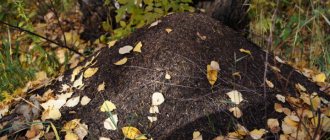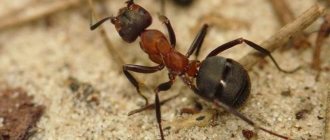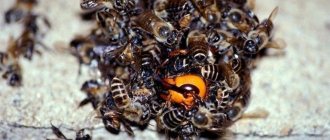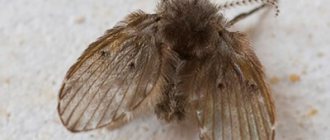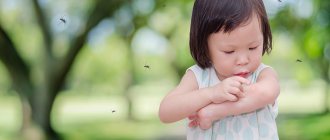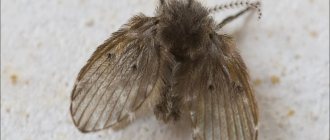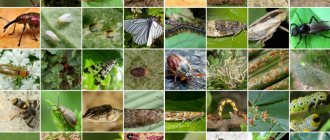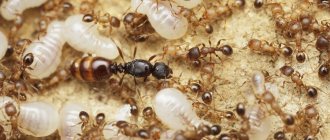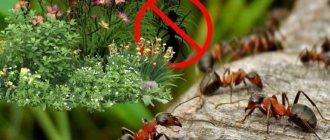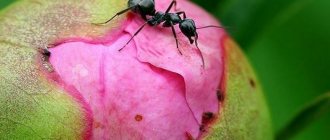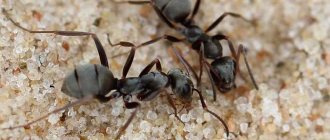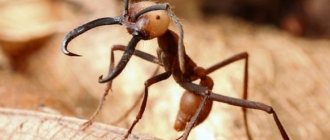If you observe carefully, you will notice how ants are constantly swarming around the aphids that have appeared on garden plants, or if ants have been noticed, you can definitely expect their “friends” aphids soon. Where does this good neighborliness come from and why do these insects interact so closely and amicably?
It is not difficult to understand this if you learn more about their lifestyle.
Aphid
These representatives of the order Hemiptera number about 4,000 species. They lead a parasitic lifestyle, feeding on plant sap, causing significant damage to cultivated plants.
When aphids appear on a plant, you can observe mutilated, curled leaves, as if coated with a slimy substance. Shoots and buds of plants lose their shape, stop developing, which is why further fruiting is completely excluded. The plant gradually withers, weakens, and becomes unable to survive the winter.
In addition to reducing yields, aphids can also transmit viral and fungal diseases (for example, sooty fungus) that affect plants.
As aphids absorb and process the sap, they secrete a sweet liquid secretion called honeydew or honeydew. This “syrup” is very attractive to many insects, including the famous sweet-toothed ants.
How to protect trees?
Tree protection can be done in several ways:
- Place trapping belts made of several layers of corrugated cardboard or plastic film on the tree trunks, tying them in two places with soft rope and applying a strip of grease along the perimeter in the central part.
- Dig a shallow hole around the perimeter of the tree and place a car tire cut in half and filled with water in it.
- Rub the tree trunks with garlic arrows, the smell of which ants cannot stand.
- Wrap wormwood grass or tomato tops onto the boles.
- Contact the nearest SES to have pest control specialists treat the trees themselves, as well as nearby plantings and anthills.
This type of relationship, such as the symbiosis between ants and aphids, has existed for millions of years - these insects depend on each other so much that they could not survive alone. If aphids appear on the site, it is necessary to simultaneously fight against both of them. If you do not fight not only aphids, but also ants, then the leaves of the plants will very soon again be covered with these harmful insects.
Ants
These are, perhaps, one of the most “social” insects, always living in families and belonging to the superfamily Antidae, the order Hymenoptera. Probably no insect is as widespread on Earth as ants, of which there are about 12 thousand species.
The main food of ants are proteins and carbohydrates, found in large quantities in seeds, plant sap and, in fact, in honeydew secreted by aphids. It is precisely for the purpose of obtaining a tasty delicacy in the form of honeydew that ants always live where there are aphids (accordingly, if there are aphids, it means that there are or will appear ants).
How to fight?
Garden ants settle in summer cottages and garden plots, spoiling the harvest and breeding countless hordes of aphids.
There are many chemical drugs against ants , the main action of which is primarily aimed at paralyzing the nervous system of these insects. Most of them are based on diazinon or chlorpyrifos.
You can fight ants in more “ecologically friendly” ways: spread anise leaves or sawdust mixed with grated garlic around the anthill. Or pour kerosene on it, but do not set it on fire.
Attention! Regular salt gives a good effect: it should be poured onto the anthill itself and the paths along which these insects move.
Wormwood and parsley growing on the site will also protect against ants that do not tolerate the smell of these herbs.
Vegetable oil, tobacco ash, crushed tomato leaves, as well as turpentine and charcoal are also good remedies against them.
But due to the fact that the greatest damage to the garden is caused not by ants, but by aphids, you need to fight them first. There are several ways to do this. The most popular methods of fighting are mechanical or manual . You can also use chemicals that will kill aphids.
You can also plant plants around your garden or garden that attract natural enemies of leaf aphids, such as ladybugs, hoverflies, lacewings and various birds.
Type of relationship between ants and aphids
The mutually beneficial relationship between aphids and ants or any other living beings is called symbiosis. What is this benefit for both sides?
Nutrition
Ants love the taste of honeydew secreted by aphids. Therefore, they have always been, are and will live where their “nurses” live. Moreover, the ants are constantly very careful to ensure that the aphids always have a “healthy diet” and, as necessary, transfer their little friends from the eaten leaf to a fresh one. That is, ants literally breed aphids on plants and trees, “graze” them and protect them from predators. Thus, everyone is happy and comfortable: aphids always have plenty of food in the form of plant sap, and the ants are thereby provided with their favorite delicacy, which the aphids treat them to in abundance.
However, ants are not only gourmets, but also good beggars: they often impatiently climb into the very thick of a flock of aphids and tickle them with their antennae, in gratitude for which the aphids immediately “gift” them with the long-awaited yummy (popularly this is often called “ants milking aphids” ).
Some species of ants even know how to store honeydew for future use. They store “food” right in their own body, in a special goiter. All types of ants have a goiter, but it is developed only in those who have adapted to use it as a storage area for food.
There are times when there are too many aphids, and then the ants eat them, thereby controlling the “population” of their feeders.
Protection
Hard-working ants not only use the “services” of their little defenseless friends, but also do a lot for them on their part: perhaps there is no better protection for aphids from predators (birds, ladybugs, etc.) than ants, who protect them so selflessly .
Moreover, around the plant on which aphids currently live and feed, their protectors, ants, build peculiar partitions from twigs, straws, and blades of grass. This fence also serves to protect the aphid “pasture” from other ants from another family and other insects.
Care
If a family of ants for some reason moves to another place of residence, they take “their own” aphids with them, without leaving the “breadwinners” to be eaten by enemies or for the use of another family.
In the fall, before the onset of cold weather, ants remove aphids from plants and take them to their anthill to spend the winter. During the winter, they take care not only of the aphids themselves, but also of their eggs. With the onset of warmth comes the time for the aphids to be “exposed” to the air and the sun. The ants carefully carry and place the “breadwinners” on fresh green leaves and continue to look after them, receiving a reward for this - their favorite honeydew.
Basic ways to combat invasion
The ants involved in breeding and dispersing aphids will leave after the disappearance of the “breadwinners”. Therefore, it is recommended to destroy smaller insects first. If you manage to get rid of these pests, the ants associated with them will also leave the area.
Ways to fight:
- Mechanical. It involves collecting pests by hand. This is painstaking and difficult work, but it allows you to sharply reduce the number of individuals and prevent their uncontrolled reproduction.
- Planting plants with a pungent odor. To prevent aphids from entering the garden, it is necessary to plant onions or garlic around its perimeter. Insects cannot tolerate the aroma emitted by these plants, so they will go looking for areas with more favorable conditions.
- Attracting natural enemies. The aphids that eat the most are ladybugs, lacewings and hoverflies. In order for these insects to settle on the site, it is necessary to plant nettles or any herb on it. At the same time, you should not take plants with a pungent odor, as it can scare away welcome guests.
- Attracting tits and sparrows. You can achieve the appearance of these birds in the garden where the pest has settled by feeding them with seeds or lard.
Ants are much more difficult to fight than aphids. To remove these insects, it is best to use chemicals. They paralyze the nervous system of the pest and lead to the death of most of the colony.
Important! When using chemicals, children and pets should not have access to the area.
Among the more humane methods are the following:
- Sawdust with grated garlic. This mixture is spread around the anthill. Insects pick up on the unpleasant odor and quickly move to a new location. Anise leaves have a similar effect.
- Salt. This food additive should be sprinkled on anthills and insect paths. Pests do not tolerate this substance, so they quickly leave the area.
- Sagebrush. This plant is planted around the perimeter of the garden. Its aroma spreads over several hundred meters, driving away any pests.
What does such a union entail for a person?
If aphids are real plant pests, and ants are their constant companions, and one cannot exist without the other, there is only one conclusion: in order not to lose the harvest, you will have to get rid of them all. But it is believed that it is more expedient to start such a fight against aphids: if they are gone, the ants will also leave in search of new “breadwinners.” But to be on the safe side, experts often advise starting the destruction of both aphids and ants at the same time, so that the latter do not manage to bring new “creators” of the favorite ant delicacy from somewhere else.
Source
Prevention measures
To prevent the appearance of harmful insects, it is necessary to carry out regular preventive measures. Before doing this work, you need to understand why it is needed, and also study the behavior of pests.
Recommended preventive measures:
- Creating a natural barrier. Planting mint, garlic, onions or marigolds will create an obstacle to the penetration of aphids and ants into the garden. These plants have a pungent odor that pests cannot tolerate.
- Weed control. They are an ideal place for laying eggs. If you regularly get rid of these plants, you can prevent the rapid increase in the insect population.
- Whitewashing trees and bushes. Aphids love to lay eggs in loose bark. A lime solution with disinfectant properties will help to avoid this.
- Collection of fallen berries and fruits. This food source attracts many harmful insects, including ants. How to effectively fight ants on fruit trees, read the article here.
- Preventive spraying. To prepare the liquid mixture, it is recommended to use ingredients of natural origin.
The symbiosis of ants and aphids is beneficial to both species. Thanks to it, insects receive everything they need to survive in the wild. For humans, such a relationship between pests causes a lot of trouble. However, if you know some of the nuances and take the necessary measures in time, you can reduce the negative impact to a minimum.
A short excursion into the life of ants
Ants are one of those few insects that are almost constantly in search of food for their ant queen and her offspring. In nature, there are approximately 12,000 species of them and all of them belong to the family of social insects. This means that they live in large individual colony families, for example, like termites.
The diet of ants consists of food rich in carbohydrates and proteins. They can safely be called a sweet tooth, and if you don’t take into account human food, which they happily “steal” and absorb, then their favorite delicacy that they can get in nature is honeydew, produced by aphids, scale insects, scale insects.
The hierarchy in the ant community is structured very simply and correctly. One family-colony of ants lives in one anthill. This is a kind of society in which everyone has their own role. The queen is the leader of this community. Its only function is to give birth to offspring. And worker ants take care of this “mother of many children” and her children. They are asexual, their main function is to search for food. In search of food, they can overcome all possible obstacles (except insecticides) and go quite far from their anthill or nest. There are also ants - soldiers. They perform the corresponding function - they guard and protect their anthill. It's simple!
Do ants on your property bring benefit or harm?
On the one hand, as we have already mentioned, ants actively destroy and eat caterpillars and other garden pests - this is undoubtedly a useful quality. In a day, residents of one medium-sized anthill destroy up to two thousand midges, caterpillars, larvae, slugs and eggs.
These insects also take part in the aeration and structuring of the soil - in places where the ant family lives, the soil contains 10 times more phosphorus and 2 times more potassium, and in a soluble form, which is easiest for plants to absorb and does not require additional processing.
Ants, by carrying seeds, contribute to the spread of about thousands of plant species. And these insects themselves are excellent food for many species of birds and some animals.
In addition, ants can serve as a kind of indicator of the condition of the site - they avoid areas with high groundwater levels or contaminated areas.
But not everything is so one-sided and rosy. The same ants themselves willingly feed on plants (berries, roots, fruits, vegetables), giving preference to foods high in sugar - remember, we talked about the carbohydrates they need. They also eagerly eat delicate flower buds, which then do not open or form one-sided, ugly flowers.
Ants, constructing their homes on your site with numerous branched underground passages, imperceptibly spoil flower beds, lawns and alpine hills, at the same time “undermining” all the plant roots that come their way.
Ants, thanks to their “waste products,” sharply increase the acidity of the soil near their settlements, which does not benefit all cultivated plants.
Ants are able to colonize tree hollows, turning even strong wood into dust.
These insects can get into residential and commercial premises, where they spoil sweet and meat products. And in cold and rainy weather, they can even temporarily “move” into your house and actively reproduce there.
Some species of ants can serve as intermediate hosts for a number of animal parasites, and also transmit bacterial and viral diseases of humans.
Ants also “breed” aphids that are harmful and dangerous to plants – let’s talk about this in more detail.
Description of the lifestyle of ants
Ants belong to the Hymenoptera order; their habitat is anthill nests, which they build underground, on stones, or inside wood. Very often other types of insects live with them and enter into symbiosis with them.
In addition to the ant hosts themselves, captured arthropods can also live in anthills - “slaves” who will perform the most difficult duties.
Despite the fact that these are small pests, they have a huge population due to their rapid reproduction. Their habitats are scattered throughout the world (with the exception of Antarctica and some lost islands in the world's oceans).
An ant colony is represented by a complex structure, where division into castes is assumed - individuals perform strictly designated functions:
- The females are also called the queen or queen. Their main and only responsibility is reproduction. Unfertilized eggs produce males, fertilized eggs produce females. The queen is distinguished by the presence of wings, which she independently chews off at the end of the summer period. The queen ant is characterized by its large size when compared with its subordinates, and it also lives much longer than all working individuals - its lifespan can reach as much as 20 years, sometimes more.
- Males are smaller in size than the queen of the family, but also have wings. Their only task is to take part in mating. After fulfilling their purpose, the males are destroyed by other ants. The lifespan of males is a maximum of several weeks.
- Working individuals/foragers - they are females who have an underdeveloped reproductive system. Their tasks are to obtain food, maintain order inside the anthill, and raise future offspring. The largest individuals, which have a large head and highly developed jaws (soldiers), are charged with protecting the nest from enemies.
Ants are considered beneficial insects, but if they settle near a person or his home, they cause a lot of inconvenience and even danger.
Note that ants are capable of damaging garden and vegetable plants, cereals, wooden houses and sheds, thereby making it possible for aphids to grow unhindered, which makes it difficult to combat them.
Signs of aphids on plants
So, the beginning of concern that aphids will soon declare war on you is the presence of a large anthill on your site. Suddenly he began to somehow get worried, and the ants were running along the trunks of the plants: know that the aphids had already appeared, and the ants were salivating.
After this, examine the tops of all young growths of plants and start with black currants, it is like an indicator: if its tops are curled up, then there are aphids for sure and, possibly, everywhere.
In addition, you can note on the leaves of various plants an atypical, lighter color, drying or deformed young shoots, falling buds (they lack nutrition), flowers that are clumsy in shape, a sticky coating on the leaves (an inch that the ants did not eat), and also corpses of dead aphids.
There is hardly any need to panic if the aphid has attacked the currant (and, as a rule, it starts with it). You should not poison your garden with chemicals, but simply cut off the tops of branches with aphids and burn them outside the site.
If the aphid has infected many plants and the ants are actively spreading it around the site, then more serious measures must be taken, since the aphid harms not only directly, weakening the immunity of plants, reducing and distorting growth, but can also be a carrier of various viral diseases, the same reversion , and a sooty fungus “sits” on the sticky secretions of the aphids, turning the plant into something terrible.
How insect friendship manifests itself
Ants and bees are the most organized insects. The organization of black ants is also evident in the careful care they take for the aphids they breed. These tireless workers, already at the onset of the first days of spring, begin to deliver aphid larvae to their future feeding site. Ants attach aphid larvae and even eggs to the swelling buds of trees and to young sprouts of vegetable crops.
This is where pests appear on young shoots. Now remember how many ants you probably saw scurrying around on tree trunks. Each of them manages to deliver more than a dozen of their future nurses in a day. Where do ants get them?
One can only marvel at the intelligence of the ants. In the fall, they collect eggs and larvae of aphids and take them to their large anthill. There they spend the winter safely. Amazingly, on days when there is a thaw, ants take their guests out of the anthill so that they can get some fresh air. In spring everything starts all over again. The symbiosis of ants and aphids continues for tens of thousands of years.
Mutual assistance between ants and aphids
Why do ants need aphids? To milk her. The ant is the shepherd of aphids. Each of them in your garden plot not only takes care of their “animal”, but also protects it from enemies. Aphids are readily eaten by ladybugs, lacewings, and hoverflies. Ants drive away these insects. For their courage and bravery, they receive a generous reward from the parasites in the form of sweet food.
The defenders even manage to protect their nurses from the birds. Of course, they cannot cope with birds in open battle. But the ants figured out how to deceive the birds. They manage to build something like roofs over aphid colonies. In this case, the birds simply do not see the aphids.
If too many of the same ladybugs or other parasite-eating insects appear on a tree or some vegetable crop where a colony of aphids has settled, then the ants help the aphids remove their proboscis from the leaves, and then transfer their “bugs” to a safe place . By the way, how do ants milk aphids? They tickle her belly and she secretes their favorite treat. They get along great with each other.
Ants carry out their service from early spring to late autumn, and their charges, accordingly, carry out their destructive activities.
The friendship and mutual assistance of these insects is so great that when the ants have to settle in a new place, they take the eggs and larvae of aphids with them.
Fighting methods
If you are not yet ready to accept an exterminator and hope to cope on your own, then keep in mind that you need to fight both aphids and ants at the same time. Various drugs containing either diazinon or chlorpyrifos can be used against ants; their action is aimed at paralyzing the nervous system of insects. Well, or fight it using biological methods, without using chemicals. We already know that ants are very sensitive to odors, so around the anthill we need to place sawdust mixed with crushed garlic, crushed or crushed (to enhance the smell) leaves of wormwood, parsley or tomatoes. The anthill can be poured with oil, turpentine or kerosene, and also sprinkled with regular salt.
At the same time, you need to fight aphids, since they cause the main damage to your plants. Leave chemicals as a last resort, since most often aphids can be defeated using a regular soap solution. For greater efficiency, you can add wood ash or baking soda to it; within a day after the first treatment you will see the result, and after repeated spraying the aphids will disappear completely. But you shouldn’t relax, continue to keep an eye on the ants and carry out preventive inspections and treatments of plants every two weeks.
Ants and aphids
How to get rid of ants from the garden
To repel pests, you can do the following:
- Make paths around the perimeter of the site using hemp oil or a mixture of sugar and yeast.
- Place small containers with kerosene or rotten fish heads, tomato tops, and garlic in the grass. The pungent smell should repel ants.
- Pour boiling water, “Belizna” or turpentine over the anthill.
- Pour salt into the tunnels made by the ants.
- Plant calendula, mint, elderberry, garlic and wormwood bushes in different parts of the site.
For example, the drug “Intra-vir” is a mixture of egg powder, sugar, vanillin and chlorpyrifos. The active substance, entering the ant’s body, paralyzes its nervous system. Chlorpyrifos lingers in the soil for up to 4 months, while its effectiveness lasts up to 2 months.
The drug contains oleic acid, which enhances the effects of chlorpyrifos.
Often baits are made from components whose particles have different diameters (semolina, sugar, etc.). Therefore, during transportation and storage of the product, delamination of the composition occurs, which reduces its effectiveness.
